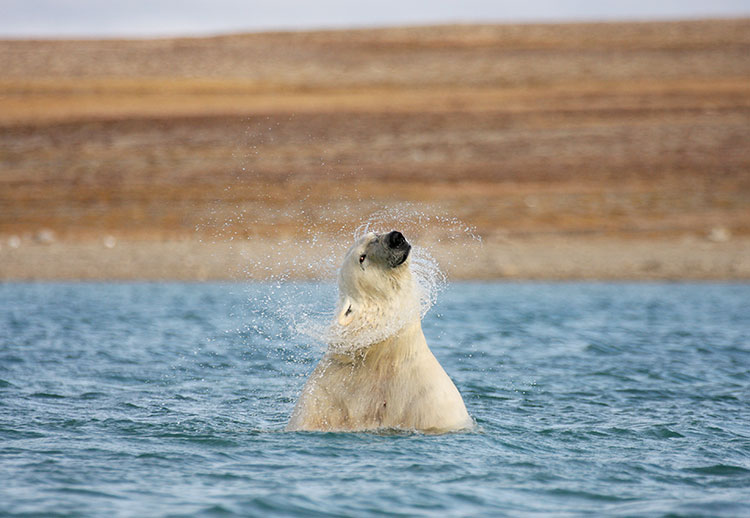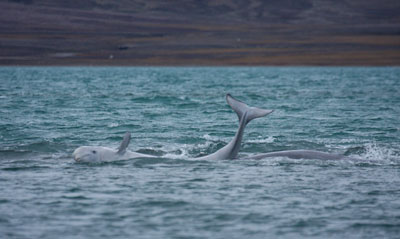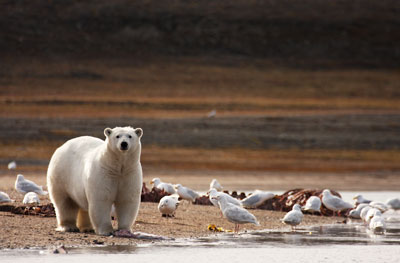Belugas and bears in the far north
We had boarded our expedition ship in Kangerlussuaq, western Greenland, and a few days later headed east across Baffin Bay to the Northwest Passage. Eight days after that we would reach Kugluktuk, in the Canadian territory of Nunavut, where we would disembark.
The Canadian High Arctic is better known for its rich and storied history of exploration as well as for the First Nations cultures, rather than for its wildlife, but the wildlife experiences that we had were outstanding.
We had an amazing time following a herd of musk ox one day, and we rode in Zodiacs along bird cliffs on another. From the ship, both walrus and Perry’s caribou were spotted in the distance. Even the most serious birders were able to add some new species to their life lists.
Midway through the passage, on Aug. 20, 2012, we were scheduled to visit Prince Leopold Island in the afternoon, then head south, but because it was a day of gray, windy and wet weather and we couldn’t land, we headed south early.
On the 21st at 10 a.m., we did a landing at Fort Ross, the last trading post built by the Hudson’s Bay Company; the fort was open 1937-1948. In early afternoon we spent about 45 minutes traversing the Bellot Strait, the passage between the northern islands in Nunavut and the northernmost tip of mainland North America.
Just before dinner, our ship arrived at Coningham Bay, on the southeast coast of Prince of Wales Island in Nunavut. In the distance, under a clearing sky, both beluga whales and polar bears were sighted from the bridge. We rushed through dinner with the promise of an “evening” Zodiac cruise afterward. At those latitudes, sunset wouldn’t be until around midnight, so we had time.
Much of the Canadian High Arctic is comprised of low, seemingly barren rocky tundra gently sloping to the sea. That late in the year, the colors were predominantly brown, with occasional small patches of color where the flora, none of it more than a few inches tall, was taking on the yellows, oranges and reds of fall.
This was the scene at Coningham Bay, a shallow, broad bay with a shoal or sandbar extending across much of the entrance, protecting the waters inside. We were anchored just outside of the sheltered sub-bay.
Almost as soon as we were in the Zodiacs, we saw belugas in the water ahead, the soft white color of the adults and the mottled gray of the young making them fairly easy to see.
Belugas are very social, often traveling in large pods near the surface. Such was the case, with 30 to 50 individuals swimming in close formation into the bay. Moving together, they created a pressure ridge of displaced water in their path through the shallows.
By chance, we were arriving during a rip tide, and the water flowing directly over the bay-mouth shoal was turbulent and fast moving. It was there that the belugas were heading in order to rub on the sand, loosening skin as they molted.
At less than 15 feet in length and with flexible necks (uncommon among cetaceans), they are able to swim in water not much deeper than their size. In apparent ecstasy, they were rolling and thrashing and generally looking like they were in heaven — tails and heads in the air and flippers flying!
We couldn’t linger over the shoal, ourselves, for fear of getting stuck, so we continued into the calm bay waters.
From the very start, we had occasionally been seeing polar bears in the water, on shore and wandering the low hills. Polar bears are typically solitary, so during the summer months the only occasion on which you are likely to see more than one at a time is when there are a mother and cub.
Bears also typically hunt from the ice edge, so their being there on a quiet bay with no ice in sight was unusual, too. Something very special was going on.
It was the belugas that attracted the bears, likely from miles around. Conditions ideal for the belugas to molt were also proving the downfall for some of them, as they were “easy pickings” while distracted in the shallow waters.
The shores were littered with countless beluga skeletons, some bleached white from years of exposure, while others were more recent kills. By the looks of things, the belugas and bears had been returning to Coningham Bay for years.
It was really impossible to take everything in. With each turn of our Zodiac craft, new bears or action would come into view. Most of the bears were rather lazily wandering about. None were thin. Glaucous gulls crowded some of the kills, but they too seemed satiated.
About three hours after we arrived, the chill began setting in and the light was fading, so we headed back to the ship, although we were too amped up to sleep.
The morning held new adventures with the bears. At one point, we enjoyed the somewhat unnerving experience of feeling like we were being hunted by two bears in the water. They could clearly smell us as the wind shifted.
One of the big males would occasionally stand up and stare at the Zodiac, then drop down and swim around a bit trying to get beside us. Another kept dipping under the water and coming up, raising his head and shaking the water from his great coat. He’d watch us awhile, then swim a bit more.
Along the shore, a mother and her cub had a quick game of tug-of-war with a bit of meat before discarding it.
I’d guess we saw 14 bears the first night and closer to 20 in the morning. It felt like the chance of a lifetime seeing so many well-fed polar bears getting along in close proximity in the wild. Thank heavens for bad weather earlier in our voyage, which led us to discover this remote bay!
MARK GRANTHAM
Aptos, CA



